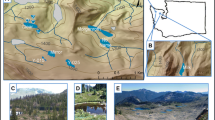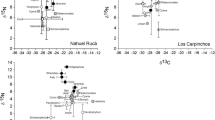Abstract
Despite a recent emphasis on understanding cross-habitat interactions, few studies have examined the ecological linkages between lakes and surrounding terrestrial habitats. The current paradigm of land–lake interactions is typically unidirectional: the view is that nutrients and matter are transported downslope from the surrounding watershed to their ultimate lacustrine destination. Emergent aquatic insects, which spend their larval stages in lake sediments and emerge as adults to mate over land, can act as vectors of material, energy and nutrients from aquatic to terrestrial habitats. In this study, we document a gradient of midge (Diptera: Chironomidae) infall rates into terrestrial habitats (measured as g dw midges m−2 d−1) surrounding eight lakes in Northern Iceland (≈66°N latitude). Lakes ranged from having virtually no midge infall (for example, Helluvaðstjörn, 0.03 g m−2 d−1) to extreme levels (for example, Mývatn, 19 g m−2 d−1) with abundances of midges decreasing logarithmically with distance from shore. Annual midge input rates are estimated as high as 1200–2500 kg midges ha−1 y−1. As midges are approximately 9.2% total N, this can result in a significant fertilization effect of terrestrial habitats with consequences for plant quality and community structure. In addition, we used naturally-occurring δ13C and δ15N isotopes to examine food web structure and diet sources of terrestrial arthropod consumers surrounding lakes with differing amounts of midge input. Terrestrial arthropods showed increased utilization of aquatic-derived (that is, midge) C relative to terrestrial sources as midge infall increased. This pattern was particularly pronounced for predators, such as spiders and opiliones, and some detritivores (Collembola). These findings suggest that, despite being largely ignored, aquatic-to-terrestrial linkages can be large and midges can fuel terrestrial communities by directly serving as resources for predators and decomposers.



Similar content being viewed by others
References
Anderson WB, Polis GA 1999. Nutrient fluxes from water to land: seabirds affect plant nutrient status on Gulf of California islands. Oecologia 118:324–32
Armitage P. 1995. Behavior and ecology of adults. In: Armitage P, Cranston OS, Pinder LCV, Eds. The Chironomidae. The biology and ecology of non-biting midges. New York: Champan and Hall. pp 194–224
Ballinger A., Lake PS. 2006. Energy and nutrient fluxes from rivers and streams into terrestrial food webs. Mar Freshw Res 57:15–28
Baxter CV, Fausch KD, Saunders WC. 2005. Tangled webs: reciprocal flows of invertebrate prey link streams and riparian zones. Freshw Biol 50:201–20
Chapin FS, Shaver GR, Giblin AE, Nadelhoffer KJ, Laundre J. 1995. Responses of arctic tundra to experimental and observed changes in climate. Ecology 76:694–711
Clarke KR, Gorley RN. 2006. PRIMER v6: user manual/tutorial, 2nd edn. Plymouth, United Kingdom: Primer-E, Ltd
Clarke KR, Warwick RM. 2001. Change in marine communities: an approach to statistical analysis and interpretation, 2nd edn. Plymouth, United Kingdom: Primer-E, Ltd
Einarsson A, Gardarsson A, Gislason GM, Ives AR. 2002. Consumer-resource interactions and cyclic population dynamics of Tanytarsus gracilentus (Diptera: Chironomidae). J Anim Ecol 71:832–45
Einarsson A, Gulati RD. 2004. Ecology of Lake Mývatn and the River Laxá: temporal and spatial variation. Aquatic Ecol 38:109
Einarsson A, Stefansdottir G, Johannesson H, Olafsson JS, Gislason GM, Wakana I, Gudbergsson G, Gardarsson A. 2004. The ecology of Lake Myvatn and the River Laxa: viation in space and time. Aquatic Ecol 38:317–48
Gardarsson A, Einarsson A, Gislason GM, Hrafnsdottir T, Ingvason HR, Jonsson E, Olafsson JS. 2004. Population fluctuations of chironomid and simuliid Diptera at Myvatn in 1977–1996. Aquatic Ecol 38:209–17
Gardarsson A, Einarsson A, Jonsson E, Gislason GM, Olafsson JS, Hrafnsdottir T, Ingvason HR. 2000. Population indices of Chironomidae at Myvatn over 20 years, 1977–1996. Myvatn, Iceland: Myvatn Research Station
Gordon C, Wynn JM, Woodin SJ. 2001. Impacts of increased nitrogen supply on high Arctic heath: the importance of bryophytes and phosphorus availability. New Phytol 149:461–71
Halaj J, Cady AB. 2000. Diet composition and significance of earthworms as food of harvestmen (Arachnida: Opiliones). Am Midl Nat 143:487–91
Hall RO, Wallace JB, Eggert SL. 2000. Organic matter flow in stream food webs with reduced detrital resource base. Ecology 81:3445–63
Henschel JR. 2004. Subsidized predation along river shores affects terrestrial herbivore and plant success. In Polis GA, Power ME, Huxel GR, Eds. Food webs at the landscape scale. Chicago, IL, USA: University of Chicago Press. pp 189–99
Henschel JR, Mahsberg D, Stumpf H. 2001. Allochthonous aquatic insects increase predation and decrease herbivory in river shore food webs. Oikos 93:429–38
Hilsenhoff WL. 1967. Ecology and population dynamics of Chironomus plumosus (Diptera—Chironomidae) in Lake Winnebago Wisconsin. Ann Entomol Soc Am 60:1183–967
Hoffmann, J. 1997. The epigeic spider fauna (Arachnida: Araneae) of some fens in north-eastern Iceland – a comparison of areas differing in ground moisture and vegetation. Fauna Norvegica Ser A 18:1–16
Ingvason HR, Olafsson JS, Gardarsson A. 2004. Food selection of Tanytarsus gracilentus larvae (Diptera: Chironomidae): an analysis of instars and cohorts. Aquatic Ecol 38:231–7
Irvine K. 2000. Macrodistribution, swarming behaviour and production estimates of the lakefly Chaoborus edulis (Diptera: Chaoboridae) in Lake Malawi. Adv Ecol Res 31:431–48
Ives AR, Einarsson A, Jansen VAA, Gardarsson A. 2008. High-amplitude fluctuations and alternative dynamical states of midges in Lake Myvatn. Nature 452:84–7
Jackson JK, Fisher SG. 1986. Secondary production, emergence, and export of aquatic insects of a Sonoran desert stream. Ecology 67:629–38
Jackson JK, Resh VH. 1989. Distribution and abundance of adult aquatic insects in the forest adjacent to a Northern California stream. Environ Entomol 18:278–83
Jonasson PM. 1979a. Ecology of eutrophic, sub-arctic Lake Myvatn and the River Laxa—Introduction. Oikos 32:2
Jonasson PM. 1979b. The Lake Myvatn ecosystem, Iceland. Oikos 32:289–305
Jonsson E, Gardarsson A, Gislason GM. 1986. A new window trap used in the assessment of the flight periods of Chironomidae and Simuliidae (Diptera). Freshw Biol 16:711–9
Kardjilov MI, Gisladottir G, Gislason SR. 2006. Land degradation in northeastern Iceland: present and past carbon fluxes. Land Degrad Dev 17:401–17
Kawaguchi Y, Nakano S. 2001. Contribution of terrestrial invertebrates to the annual resource budget for salmonids in forest and grassland reaches of a headwater stream. Freshw Biol 46:303–16
Knight TM, McCoy MW, Chase JM, McCoy KA, Holt RD. 2005. Trophic cascades across ecosystems. Nature 437:880–3
Kohler J, Hilt S, Adrian R, Nicklisch A, Kozerski HP, Walz N. 2005. Long-term response of a shallow, moderately flushed lake to reduced external phosphorus and nitrogen loading. Freshw Biol 50:1639–50
Likens GE. 1985. An ecosystem approach to aquatic ecology: mirror Lake and its environments. New York: Springer-Verlag
Lindegaard C, Jonasson PM. 1979. Abundance, population dynamics and production of zoobenthos in Lake Myvatn, Iceland. Oikos 32:202–27
Lundberg J, Moberg F. 2003. Mobile link organisms and ecosystem functioning: implications for ecosystem resilience and management. Ecosystems 6:87–98
MacKenzie RA, Kaster JL. 2004. Temporal and spatial patterns of insect emergence from a Lake Michigan coastal wetland. Wetlands 24:688–700
Milner AM, Fastie CL, Chapin FS, Engstrom DR, Sharman LC. 2007. Interactions and linkages among ecosystems during landscape evolution. Bioscience 57:237–47
Moore JW, Schindler DE, Carter JL, Fox J, Griffiths J, Holtgrieve GW. 2007. Biotic control of stream fluxes: spawning salmon drive nutrient and matter export. Ecology 88:1278–91
Murakami M, Nakano S. 2002. Indirect effect of aquatic insect emergence on a terrestrial insect population through predation by birds. Ecol Lett 5:333–7
Nakano S, Hitoshi M, Noatoshi K. 1999. Terrestrial-aquatic linkages: riparian arthropod inputs alter trophic cascades in a stream food web. Ecology 80:2435–41
Olafsson JS. 1979. The chemistry of Lake Mývatn and River Laxá. Oikos 32:82–112
Paetzold A, Schubert CJ, Tockner K. 2005. Aquatic terrestrial linkages along a braided-river: Riparian arthropods feeding on aquatic insects. Ecosystems 8:748–59
Petersen I, Winterbottom JH, Orton S, Friberg N, Hildrew AG, Spiers DC, Gurney WSC. 1999. Emergence and lateral dispersal of adult Plecoptera and Trichoptera from Broadstone Stream, UK. Freshw Biol 42:401–16
Polis GA, Anderson WB, Holt RD. 1997. Towards an integration of landscape and food web ecology: the dynamics of spatially subsidized food webs. Ann Rev Ecol Syst 28:289–316
Polis GA, Hurd SD. 1995. Extraordinarily high spider densities on islands: flow of energy from the marine to terrestrial food webs and the absence of predation. Proceedings of the National Academy of Sciences of the United States of America 92:4382–6
Polis GA, Hurd SD. 1996. Linking marine and terrestrial food webs: allochthonous input from the ocean supports high secondary productivity on small islands and coastal land communities. Am Nat 147:396–423
Polis GA, Power ME, Huxel GR, Eds. 2004. Food webs at the landscape scale. Chicago, IL, USA: University of Chicago Press
Polis GA, Winemiller KO. 1996. Food webs: Integration of patterns and dynamics. New York, NY: Chapman and Hall
Power ME, Rainey WE, Parker MS, Sabo JL, Smyth A, Khandwala S, Finlay JC, McNeely FC, Marsee K, Anderson C. 2004. River-to-watershed subsidies in an old-growth conifer forest. In: Polis GA, Power ME, Huxel GR, Eds. Food webs at the landscape scale. Chicago, IL, USA: University of Chicago Press. pp 217–40
Sabo JL, Power ME. 2002. River-watershed exchange: effects of riverine subsidies on riparian lizards and their terrestrial prey. Ecology 83:1860–9
Sanzone DM, Meyer JL, Marti E, Gardiner EP, Tank JL, Grimm NB. 2003. Carbon and nitrogen transfer from a desert stream to riparian predators. Oecologia 134:238–50
SAS Institute. 2007. JMP user’s guide. Cary, NC: SAS Institute Inc
Shaver GR, Bret-Harte SM, Jones MH, Johnstone J, Gough L, Laundre J, Chapin FS. 2001. Species composition interacts with fertilizer to control long-term change in tundra productivity. Ecology 82:3163–81
Shevtsova A, Nilsson MC, Gallet C, Zackrisson O, Jaderlund A. 2005. Effects of long-term alleviation of nutrient limitation on shoot growth and foliar phenolics of Empetrum hermaphroditum. Oikos 111:445–58
Southwood TRE. 1966. Ecological methods, with particular reference to the study of insect populations. London: Methuen
Vadeboncoeur Y, Vander Zanden MJ, Lodge DM. 2002. Putting the lake back together: reintegrating benthic pathways into lake food web models. Bioscience 52:44–54
Valderrama J. 1981. The simultaneous analysis of total nitrogen and total phosphorus in natural waters. Mar Chem 10:109–22
Wolfe AP, Cooke CA, Hobbs WO. 2006. Are current rates of atmospheric nitrogen deposition influencing lakes in the Eastern Canadian Arctic? Arct Antarct Alp Res 38:465–76
Acknowledgments
We would like to thank foremost Dr. Árni Einarsson for introducing us to Iceland and giving us the logistic, intellectual, and enthusiastic support that allowed us to carry out this work in Iceland. Much appreciated are the discussions of spatial subsidies with A. Ives, B. Peckarsky, and P. Townsend, who helped shape some of the ideas in this study. Thanks to E. Stanley, C. Kingdon, N. Tull and N. Klick for help in data collection, analysis and sample preparation, and A. Kruger for performing the stable isotope analyses. Comments from three anonymous reviewers significantly improved earlier manuscript drafts. Support for this project came in part from the National Science Foundation (Ecosystems, DEB-0717148), University of Wisconsin College of Agriculture and Life Sciences Research Division and International Studies Program, and the UW Graduate School. Special thanks to I. Goldman, K. Shapiro, and D. Paulnock for helping to get this project off the ground.
Author information
Authors and Affiliations
Corresponding author
Additional information
Author contributions: CG conceived and designed the study, helped perform the research, analyzed the data, and wrote the manuscript. JRD and JVZ helped design the study and perform the research. Additionally, JVZ assisted with writing and contributed editorial input.
Electronic supplementary material
Rights and permissions
About this article
Cite this article
Gratton, C., Donaldson, J. & Zanden, M.J.V. Ecosystem Linkages Between Lakes and the Surrounding Terrestrial Landscape in Northeast Iceland. Ecosystems 11, 764–774 (2008). https://doi.org/10.1007/s10021-008-9158-8
Received:
Revised:
Accepted:
Published:
Issue Date:
DOI: https://doi.org/10.1007/s10021-008-9158-8




